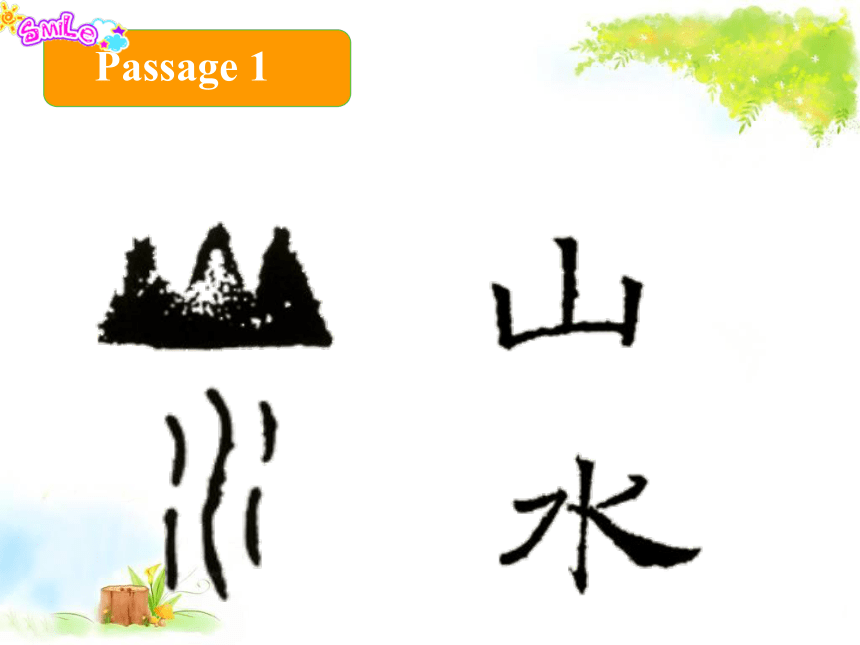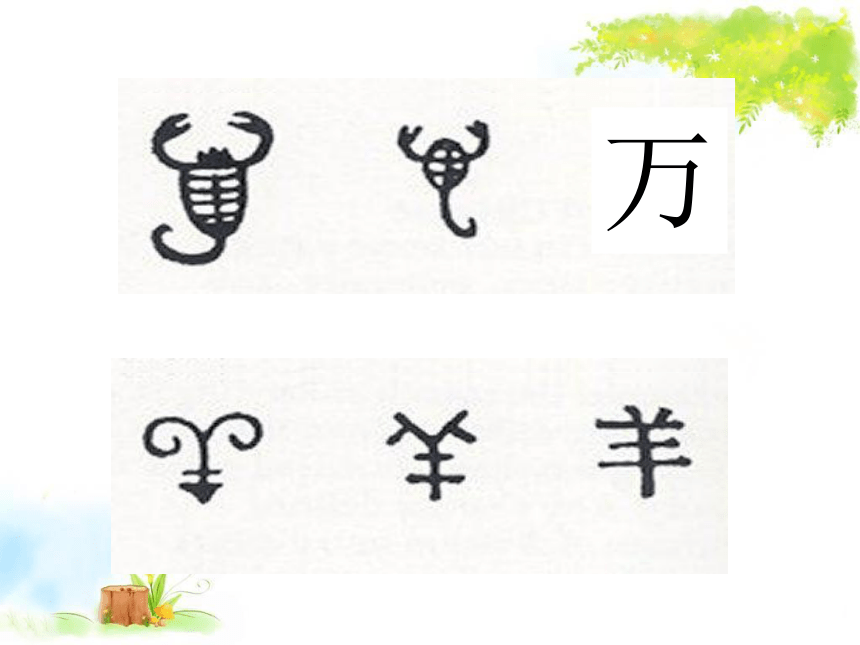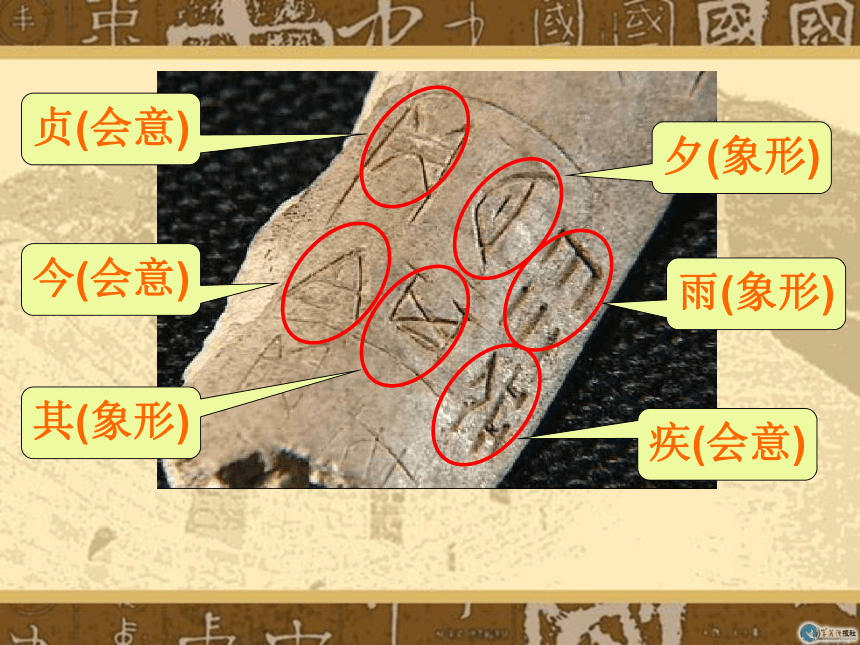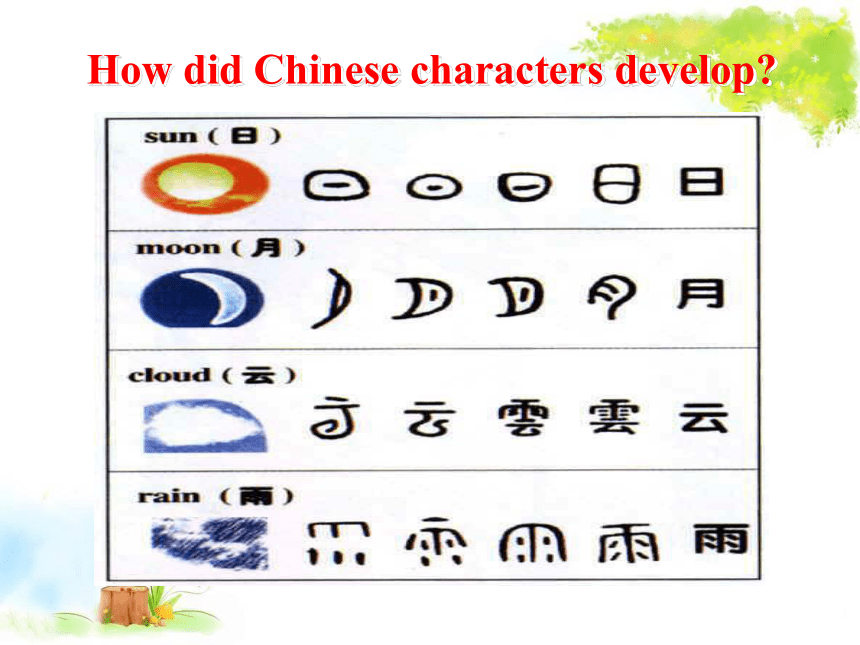牛津译林版高一下册模块3Unit 2 Language Project课件 (18张PPT)
文档属性
| 名称 | 牛津译林版高一下册模块3Unit 2 Language Project课件 (18张PPT) |  | |
| 格式 | zip | ||
| 文件大小 | 784.0KB | ||
| 资源类型 | 教案 | ||
| 版本资源 | 牛津译林版 | ||
| 科目 | 英语 | ||
| 更新时间 | 2020-04-01 11:59:24 | ||
图片预览







文档简介
(共18张PPT)
Passage 1
万
Can you make out any of these Chinese characters?
贞(会意)
今(会意)
疾(会意)
夕(象形)
雨(象形)
其(象形)
How did Chinese characters develop?
The development of Chinese characters
1、What is the article about?
The development of Chinese characters
2、Who invented Chinese characters?
Cang Jie
3、Chinese characters are developed from or for ______?
Drawing of objects, two or more characters, directions and numbers
4、What did Chinese government do in the 1950s?
The Chinese government introduced simplified Chinese characters .
True or False
1.The Chinese language differs from many Western languages because Western languages use characters which have meanings and can stand alone as words.
2. Chinese words can only be formed by putting together different characters to stand for ideas, objects or deeds.
3. Cang Jie got the idea of Chinese writing from the tracks of animals.
4. Cang jie invented the first Chinese characters which used shapes or pictures to represent different objects.
5. All the Chinese characters have been simplified from time to time.
6. The first real Chinese characters were drawings of objects which turned into standard forms and became more complex over time.
7. Two or more characters are combined to express other ideas.
8. The character formed by a man inside a square means that he is a prisoner.
9. All our Chinese characters have one part to indicate
the meaning and the other part to suggest the
pronunciation.
10. The simplified Chinese characters are widely used
in mainland China.
Main idea of each part.
Paragraph ( )
Paragraph ( )
Paragraph ( )
Paragraph ( )
The origins of Chinese
characters.
Pronunciation and
simplification of Chinese
characters.
Form and development of
Chinese characters.
Brief introduction of
Chinese characters.
1
2
3
4-5
Passage 2
The story of Braille
Louis Braille and Braille
1、At the age of three, Braille
lost his eyesight as a result of an injury
2、When Braille was ten, he
went to a school for the blind in Paris.
3、When Braille was twelve,
a soldier showed him a system for passing
messages at night during the battle.
4、At the age of fifteen,
he created a system with pattern of six raised
dots representing each letter.
True or False
1、Braille was born blindly.
2、The school Braille went to had a library with
only 14 books for the blind.
3、There were twenty-six patterns and twelve
dots in each pattern in the soldier’s system.
4、There were only six raised dots for each
letter in the system created by Braille.
5、The blind can easily write in ink with the
help of the system created by Braille.
6、Different language has different version of
Braille for the blind to use.
7、The soldier and Braille invented the system for the
blind together.
soldier
Influence
Normal
which
fourteen
night
felt
Twenty-six
Six
common
version
The structure of this passage
Forms and development of Chinese characters
Pictographs
象形字
Ideographs
会意字
Indicatives
指事字
pictophonetic
形声字
Characters made by combining two or more elements together
The form of the characters which are used to indicate directions and numbers
Characters consisting of the semantic (语意的) radical and phonetic (语音的) radical
The first real Chinese
characters
Translate the following sentences into English, using the words or phrases in the brackets.
1.你知道大学与高中有什么不同吗? (differ)
Do you know how college differs from high school?
2. 字母表中的字母代表读音。 (represent)
Letters of the alphabet represent sounds.
3. 整体来看,这本书值得一读。(as a whole)
As a whole, the book is worth reading.
4. 这个故事被简写了,以便于更容易理解。(simplify)
The story has been simplified to make it easier to understand.
5. 我认为电影应该集教育与娱乐于一体。(combine ... with)
I think films should combine education with recreation.
Passage 1
万
Can you make out any of these Chinese characters?
贞(会意)
今(会意)
疾(会意)
夕(象形)
雨(象形)
其(象形)
How did Chinese characters develop?
The development of Chinese characters
1、What is the article about?
The development of Chinese characters
2、Who invented Chinese characters?
Cang Jie
3、Chinese characters are developed from or for ______?
Drawing of objects, two or more characters, directions and numbers
4、What did Chinese government do in the 1950s?
The Chinese government introduced simplified Chinese characters .
True or False
1.The Chinese language differs from many Western languages because Western languages use characters which have meanings and can stand alone as words.
2. Chinese words can only be formed by putting together different characters to stand for ideas, objects or deeds.
3. Cang Jie got the idea of Chinese writing from the tracks of animals.
4. Cang jie invented the first Chinese characters which used shapes or pictures to represent different objects.
5. All the Chinese characters have been simplified from time to time.
6. The first real Chinese characters were drawings of objects which turned into standard forms and became more complex over time.
7. Two or more characters are combined to express other ideas.
8. The character formed by a man inside a square means that he is a prisoner.
9. All our Chinese characters have one part to indicate
the meaning and the other part to suggest the
pronunciation.
10. The simplified Chinese characters are widely used
in mainland China.
Main idea of each part.
Paragraph ( )
Paragraph ( )
Paragraph ( )
Paragraph ( )
The origins of Chinese
characters.
Pronunciation and
simplification of Chinese
characters.
Form and development of
Chinese characters.
Brief introduction of
Chinese characters.
1
2
3
4-5
Passage 2
The story of Braille
Louis Braille and Braille
1、At the age of three, Braille
lost his eyesight as a result of an injury
2、When Braille was ten, he
went to a school for the blind in Paris.
3、When Braille was twelve,
a soldier showed him a system for passing
messages at night during the battle.
4、At the age of fifteen,
he created a system with pattern of six raised
dots representing each letter.
True or False
1、Braille was born blindly.
2、The school Braille went to had a library with
only 14 books for the blind.
3、There were twenty-six patterns and twelve
dots in each pattern in the soldier’s system.
4、There were only six raised dots for each
letter in the system created by Braille.
5、The blind can easily write in ink with the
help of the system created by Braille.
6、Different language has different version of
Braille for the blind to use.
7、The soldier and Braille invented the system for the
blind together.
soldier
Influence
Normal
which
fourteen
night
felt
Twenty-six
Six
common
version
The structure of this passage
Forms and development of Chinese characters
Pictographs
象形字
Ideographs
会意字
Indicatives
指事字
pictophonetic
形声字
Characters made by combining two or more elements together
The form of the characters which are used to indicate directions and numbers
Characters consisting of the semantic (语意的) radical and phonetic (语音的) radical
The first real Chinese
characters
Translate the following sentences into English, using the words or phrases in the brackets.
1.你知道大学与高中有什么不同吗? (differ)
Do you know how college differs from high school?
2. 字母表中的字母代表读音。 (represent)
Letters of the alphabet represent sounds.
3. 整体来看,这本书值得一读。(as a whole)
As a whole, the book is worth reading.
4. 这个故事被简写了,以便于更容易理解。(simplify)
The story has been simplified to make it easier to understand.
5. 我认为电影应该集教育与娱乐于一体。(combine ... with)
I think films should combine education with recreation.
